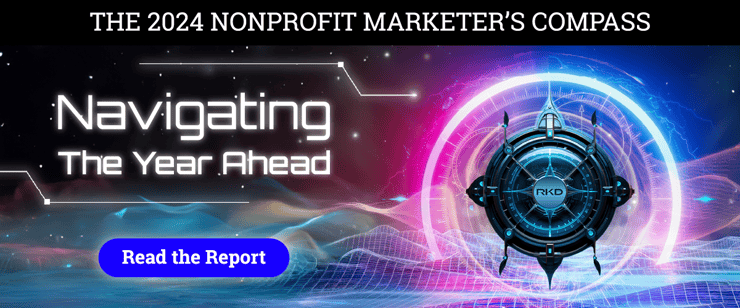How frequently should I be communicating with my donors?
It’s a common question nonprofits grapple with, yet there’s no one-size-fits-all answer. The frequency of communication varies significantly depending on the organization and its targeted audience.
While there are some general best practices to consider, the most effective approach to determining communication frequency with any specific audience is rooted in understanding their unique context.
One of the beacons in RKD’s 2024 Nonprofit Marketer’s Compass is to think dimensionally. This beacon is all about leveraging data to gain deeper insights into donors’ context, interests, behaviors and motivations. With a multi-dimensional perspective, organizations can develop a more nuanced understanding of their donors.
Today, nonprofits have access to many tools and resources to construct a comprehensive view of their donors. Armed with this contextual understanding, organizations can craft communication strategies that are both informed and empathetic, fostering trust and engagement among donors.
In this article, we'll cover how nonprofits can harness data and advanced analytics to gain profound insights into their donors, enabling more meaningful and impactful conversations across diverse audience segments.
Start by understanding who “they” are
Rather than starting with the number of pieces on a set communication calendar, it’s time to start with the audience.
Each audience within your mission’s donor file has different wants, needs and propensities to give. Understanding this data will help inform how you interact with them.
There are many ways you can start to paint a clearer picture for each of your audiences. A few ways we’re helping Mission partners do this include:
- Market research: Today’s world is rapidly changing, with donor trust declining and competition for their money and attention rising. What better way to understand what a donor, or a prospective supporter, wants and thinks of your mission than to ask them? Engaging in market research provides invaluable direct feedback from donors and potential supporters. This approach lays the groundwork for establishing a baseline understanding of donor sentiments and perceptions towards your cause.
- Connected data infrastructure: You can’t truly understand an audience with siloed data. As data privacy rules tighten, first-party data becomes essential and donors expect more personalized communication, missions must adapt their marketecture to keep up. This means investing in a CRM that can collect diverse data sources—and having an ecosystem that integrates it all together seamlessly.
- Advanced analytics: Leveraging modeling and analytics uncovers hidden opportunities within your audience segments. For instance, our clients have successfully utilized RKD's Velocity model, a predictive selection tool that uses machine learning to pinpoint underperforming direct mail audiences. Armed with these insights, organizations can implement tailored strategies to enhance engagement and drive better outcomes.
Tailor your message by segment to meet their "wants”
Once you understand each audience’s wants, preferred channels and propensity to give, you can tailor your communication calendar by segment to best meet their preferences.
We mentioned RKD’s Velocity model above, and one our clients recently used the tool to identify underperforming segments that weren’t giving them a return on their investment. Once identified, they cut the investment spent on this segment and redeployed the savings toward new strategies and tactics that deliver a higher ROI.
For example, before being identified by Velocity, their lapsed audience was receiving a newsletter with a historically low response rate. By pivoting strategies and implementing a more effective message, ROI for this audience increased by 347%.
Continuously listen and adapt
RKD’s study “Listen Up: The Nonprofit Marketer’s Guide to Trust” underscored the importance of transparency and competence as primary drivers of trust.
Donors seek a lucid understanding of how your organization intends to realize its mission, along with tangible insights into how their contributions will facilitate its achievement. The study also revealed a nuanced aspect: different audiences prefer varying frequencies and channels for receiving communication.
As you tailor and refine your communication strategies to cater to each audience segment, it's vital to cultivate a receptive mindset. Beyond merely analyzing metrics like response rates, explore more ways to actively solicit feedback from your donors. Embracing this iterative approach fosters a deeper connection with your supporters and enhances your ability to meet their evolving needs effectively.
Feedback, whether positive or negative, serves as a valuable tool for identifying opportunities for improvement in both the short and long term.
So, let's get back to the question ... or maybe by now, you're asking a new one: rather than asking how often you should contact a group of donors, consider if you are creating personalized donor experiences across channels. Then, you can contact each donor the exact number of times you have something meaningful and relevant to share with them.
You can start taking action today by examining how you can:
- Collect more email addresses and mobile numbers
- Conduct data hygiene
- Implement a platform to connect your donor and volunteer database, email service provider and online donation platform
Connecting more data dots can help you deepen donor connections by actively observing, analyzing and responding to their signals. Let their actions and preferences guide your communication strategy, forging stronger, more authentic relationships that drive lasting impact.
This blog was written in collaboration with Vice President of Client Partnership, Heidi Riehl.
Additional Resources
- Religion is declining in the US: Here’s what that means for faith-based nonprofits
- Rescue mission donors are changing, and these charts prove it
- Unlocking digital growth: How 3 rescue missions are setting the bar
- It’s time for missions to rethink donor journeys
- How rescue missions can spur major donor pipeline growth






Leave a comment: